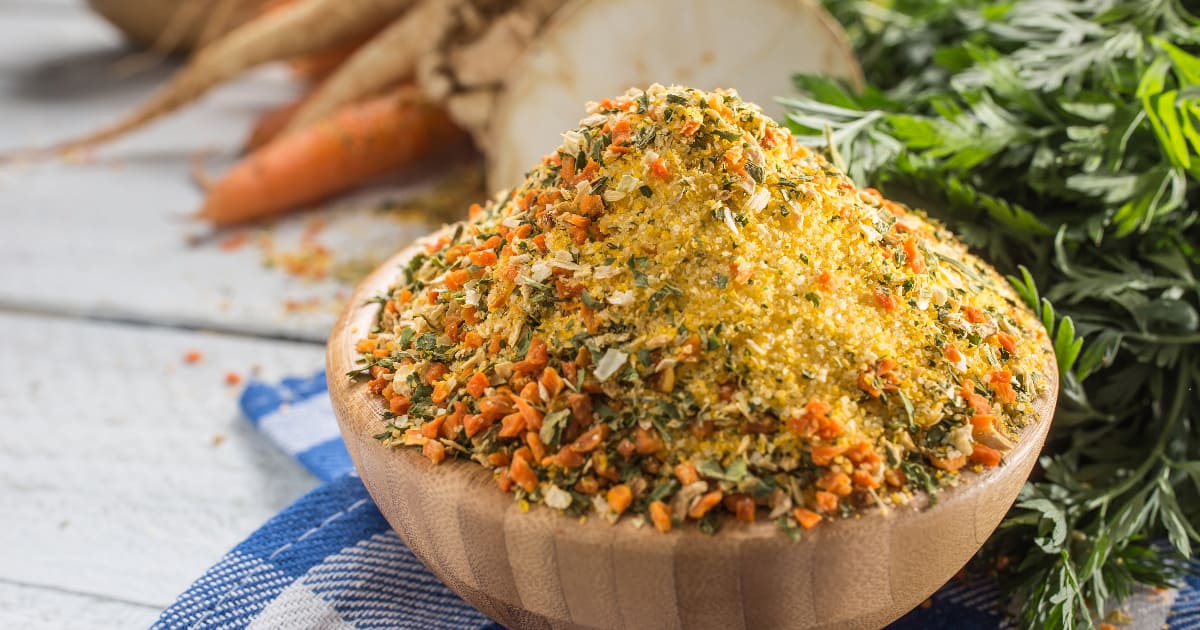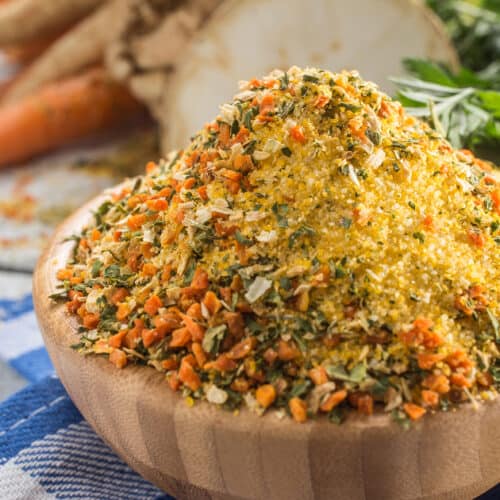Homemade vegetable powder is a versatile ingredient that can be used to add nutrition and flavor to many dishes.

By dehydrating fresh vegetables and then grinding them into a fine powder, you can make your own customized blends that are healthier and more affordable than store-bought options.
There are several benefits to making DIY vegetable powders at home:
Cost Savings - Store-bought powders can be expensive, especially if you want good quality, non-GMO, or organic options. Making your own allows you to get more value from vegetables you grow or buy in bulk when in season.
Control Ingredients - You can choose exactly which vegetables to include and leave out any additives, preservatives, or anti-caking agents found in commercial mixes. Customize blends to suit your taste and nutrition needs.
Preserve Fresh Produce - Powdering lets you make use of a surplus harvest or leftover veggies that might otherwise go bad. It saves freezer space compared to keeping chopped veggies.
Add Nutrients - Whipping up a veggie smoothie? Toss some powders in! Make nutrient-dense pasta dough or bake nutritious bread with added vegetable goodness. Powders help you eat more plants!
Enhance Flavor - Onion, garlic, tomato and other powders make flavorful salt-free seasonings. Spice up soups, stews, grains and more.
Key Takeaway: Making your own DIY vegetable powders at home saves money, gives you total control of ingredients, helps use up fresh produce before it spoils, adds extra nutrition, and boosts flavor in cooking.
How to Make Vegetable Powder

Homemade Vegetable Powder Recipe
Ingredients
- Vegetables of your choice
Instructions
Select and Prepare Vegetables
- Almost any vegetable can be dried and powdered! Good options include:
- Roots: beets, carrots, sweet potatoes
- Fruits: tomatoes, peppers, corn, zucchini, winter squash
- Greens: kale, spinach, Swiss chard, cabbage
- Others: onions, garlic, celery, herbs
- Rinse produce well. Remove any bruised portions. Peel if desired. Slice, dice, or shred into small thin pieces to speed drying.
Dehydrate Vegetables
- Oven Method:
- Line baking sheets with parchment. Spread veggies in a single layer, avoiding overlap. Bake at lowest oven temp (170°F - 200°F) with the door propped open slightly, until completely dried and brittle. Time varies based on moisture content.
- Stir veggies halfway through. Rotate pans if drying unevenly. Let cool completely before next step.
- Dehydrator Method:
- Follow manufacturer guidelines for pretreating and loading trays. Dry at 135°F until hard and crisp.
Grind Dehydrated Veggies into Powder
- A blender, food processor, coffee grinder, or mortar and pestle can all grind dried vegetables into a fine powder. Work in small batches. You may need to grind in stages, sifting out larger pieces to regrind.
Store in Airtight Containers
- Glass jars with tight lids are ideal for storage. Stash containers in a cool, dark place. Most powders keep 6 months to 1 year. For longer storage up to 2 years, freeze powders.
Vegetable Powder Uses
Homemade veggie powders are endlessly versatile! They add flavor, nutrition, and color to many dishes:
Seasonings - Make customized salt-free blends. Onion, garlic, tomato powders = instant umami flavor.
Broths & Soups - Whisk powders into hot water for quick nutrient-rich broth. Use as soup stock base or thickeners.
Baked Goods - Stir powders into doughs, batters and fillings. Carrot, beet, and spinach powders nicely color breads.
Smoothies - Blend powders into fruit smoothies, protein shakes or green juices. Mask strong flavors like spinach.
Pasta - Mix powders into pasta dough or toss with finished noodles. Colorful beet or carrot powders make fun pasta.
Dips - Make ranch dressing and dips with onion or garlic powder. Add nutrition to hummus.
Meat Dishes - Sprinkle powders over meats before cooking. Mix into ground meats for added nutrition.
Casseroles - Fold powders into cheesy casserole bakes, mac and cheese, egg bakes to up the veggie content.
Snacks - Shake powders over popcorn or home chips for flavor. Make nutrition bars with powders.
DIY Supplements - Fill capsules with powders as natural vitamin supplements.
The options are endless! Experiment with powders in your own cooking.
Tips for Making Great Vegetable Powders
Follow these tips for getting the most from your homemade vegetable powders:
- Pretreat vegetables with salt, lemon juice or blanching to preserve color and flavor during dehydrating.
- When mixing custom blends, group ingredients with compatible flavors and textures.
- Store powders containing garlic or onions separately as their flavors intensify over time.
- Freeze powders you won't use within 6 months for longest nutrient retention.
- Choose produce at peak freshness and wash well before dehydrating for best results.
- Keep an eye on oven drying vegetables to prevent scorching. Stir occasionally for even drying.
- Use a powerful blender for smoothest powder texture. A coffee grinder also works well.
- Sift out fibrous bits after grinding. Re-grind large pieces left behind.
Storing Your Vegetable Powders
The best way to store homemade vegetable powders is in airtight glass jars or containers kept in a cool, dark place. Always label jars with powder name and date.
Powders will usually stay fresh for 6 months to 1 year when properly stored. You can extend shelf life up to 2 years by storing jars in the freezer.
Before use, check powders for moisture clumping, faded color, or "off" odors indicating spoilage. Discard if qualities have noticeably deteriorated.
FAQs
What's the best dehydrator to use?
Excalibur, Sedona, and Nesco dehydrators are top-rated brands. Look for adjustable temp controls and a fan or convection drying feature.
Can I use a regular blender to grind powders?
Yes, but a more heavy-duty blender will get a finer, smoother powder texture. Use short pulses, shaking jar often to dislodge bits.
Do I need to peel vegetables before dehydrating?
Peeling is optional for most veg. Unpeeled produce will have more fiber. Peel waxy skins like beets or squash for faster moisture release.
How long does homemade vegetable powder last?
Kept cool, dark, and dry in airtight containers, powders stay fresh 6 months up to 1 year. For longer 2 year storage, freeze jars.
What vegetables don't dehydrate well?
Leafy greens like lettuce turn bitter when dried. Soft fruits like grapes don't become crisp enough to powder. Starchy root veg take longer drying.
Conclusion
Whipping up homemade vegetable powders is simple and rewarding! Using the oven drying method, you can turn fresh garden produce into concentrated, shelf-stable veggie goodness. Customize powder blends to add nutrition, vibrant colors, and flavors to all kinds of recipes in your cooking.
With a little practice, you’ll be hooked on keeping a variety of nourishing veggie powders on hand. They make great use of seasonal gluts and surplus harvests from the garden. Plus you control exactly what goes into them – no preservatives, additives or anti-caking compounds.

